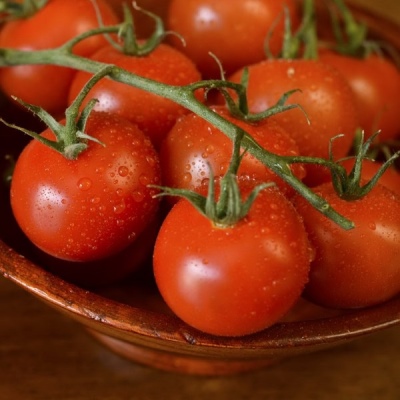
- Category: hybrid
- Appointment: fresh consumption, for pickling and preserving
- Ripening period: early
- Growing conditions: for film greenhouses
- Marketability: high
- Bush size: tall
- Bush height, cm: more than 150
- Ripe fruit color: Red
- Fruit shape: rounded
- Yield: up to 7 kg per bush
Tall tomato varieties are less in demand among summer residents, as they require more attention than determinant crops. Although, unlike other plants, they are capable of producing large yields from a small area. Tomato Kisteva is a domestic breeding novelty that appeared on the agricultural market in 2017. The culture is not particularly whimsical to care for, it is possible to grow it even in the harsh climatic conditions of Siberia.
Description of the variety
The variety is of an indeterminate type. The bushes are tall, the height is 150 cm, they must be tied up, pinned and shaped. Leaves of normal length, green. 18-20 fruits are formed on one cluster.
It is preferable to grow Tomato Kisteva in film greenhouses, but it is also possible in the open field. Growing conditions depend on the climatic conditions of the region, the variety feels great even in the northern regions of Russia.
The main qualities of the fruit
Fruits are small in size, weighing 90-110 g. Their shape is round. The color of ripe tomatoes is red. The skin is smooth. The pulp is dense, fleshy, juicy. Ripe fruits lie very well, showing high resistance to cracking, which guarantees a long shelf life - about a month.
Taste characteristics
The taste of tomato Kistevoy is sweet and sour. The fruits are used both fresh and processed. They can be canned whole, juices, pasta, dressings can be made. Especially the taste of tomatoes is revealed in salads.
Ripening and fruiting
On the 95-105th day, the technical ripeness of the tomato begins, from the moment the shoots appear. Refers to early maturing varieties. Fruiting begins in the second half of July-August.
Yield
High-yielding hybrid. From one bush, you can collect about 7 kg of fruit. Productivity is 90%. From one square meter, 27-36 kg of tomatoes are obtained. The harvested tomatoes lie well, during transportation they do not lose their presentation. The plant is capable of producing a stable yield even with a lack of heat.
The timing of planting seedlings and planting in the ground
To obtain strong seedlings, the seedling method is used. Before starting sowing, the seeds are first disinfected in a weak solution of potassium permanganate, leaving them in it for several hours. For planting, choose a fertile soil, it is better to use a ready-made substrate. 1 cm holes are made in a container, seeds are sown and sprinkled with earth, slightly compacting the soil.
Sowing is done in early March. A week before planting seedlings in a permanent place, it must be hardened. By mid-April, the seedlings can be planted in a permanent place in the greenhouse; in May-June, the plant is transplanted into open ground. However, this method is preferable to use for the southern regions and the middle zone.
Watering should be moderate. Excess moisture leads to root rot. Complex mineral fertilizers are applied once every 2 weeks.

Growing tomato seedlings is an extremely important process, because it largely depends on whether the gardener will be able to harvest at all. All aspects must be taken into account, from seedbed preparation to planting in the ground.
Landing scheme
The plant is quite powerful, spreading and high, the distance between the holes is 30-50 cm, between the tomatoes - 40-60 cm. So they will not thicken each other. For 1 sq. m planted no more than 3 seedlings.

Growing and care
Tomato Kistevoy tolerates unfavorable weather conditions. The variety is stress-resistant and tolerates transplanting well. Not picky about the composition of the soil. Grows well on sandy loam and loamy soils. However, for successful development, additional compost or humus should be added to saturate the earth with nutrients.
The culture is especially demanding on the quality of irrigation. Irrigation is carried out in the evening, after sunset, with warm water under the root. When watering, you need to try so that moisture does not get on the leaves. For less water loss in the soil, mulching, loosening and hilling are carried out.
The bushes must be formed, leaving a few shoots, the rest are removed, just like the stepsons. The plant must be tied to a trellis or support. Also, do not forget about feeding. After planting, nitrogen is introduced, it makes it possible to increase the green mass of the hybrid. When the flowering and fruit set begins, the soil is enriched with potassium, phosphorus and magnesium.




A plant needs different micronutrients at each stage of growth. All fertilizers can be divided into two groups: mineral and organic. Folk remedies are often used: iodine, yeast, bird droppings, eggshells.
It is important to observe the rate and period of feeding. This also applies to folk remedies and organic fertilizers.
Disease and pest resistance
Tomato Kistevoy has good persistent immunity to many fungal and viral diseases, if all agrotechnical conditions are observed during cultivation. But in order to exclude possible damage to the plant by various pests, during the flowering period, prophylactic treatment of the bushes with special preparations is carried out.



























































































